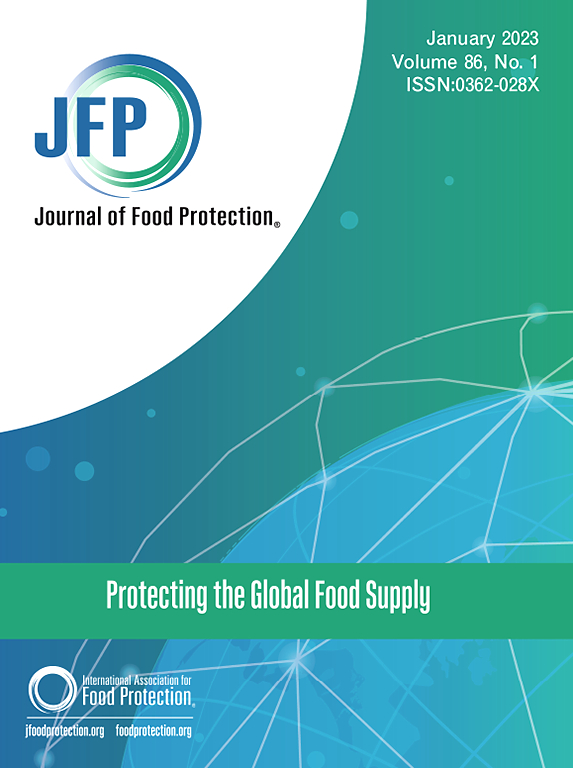An outbreak of Shiga Toxin-producing Escherichia coli Serotype O145:H28 Associated with Domestic Travel and Consumption of Unpasteurized Cheese, UK, 2023
IF 2.1
4区 农林科学
Q3 BIOTECHNOLOGY & APPLIED MICROBIOLOGY
引用次数: 0
Abstract
Unpasteurized dairy products carry an inherent risk of being contaminated with STEC and/or other zoonotic gastrointestinal pathogens. In November 2023, a genetically linked and geographically dispersed outbreak of 36 cases of Shiga toxin-producing Escherichia coli (STEC) O145:H28 was detected by the foodborne gastrointestinal pathogens surveillance systems at the UK Health Security Agency, using whole genome sequencing. Reported symptoms included diarrhoea (81%), bloody diarrhoea (65%), vomiting (84%), and 47% of cases were admitted to hospital. A review of the completed enhanced surveillance questionnaires (n = 29) revealed 18 cases reporting travelling first class on trains operated by the same company prior to onset of symptoms, of which 16/18 consumed the same meal which included an unpasteurized cheese. Microbiological testing of the cheese products did not detect the outbreak strain; however, STEC O145:H28 was detected in two bovine fecal samples collected at the dairy farm where the unpasteurized cheese was produced. Analysis of the genome sequencing data confirmed that the 36 human STEC O145 isolates and the two bovine STEC O145 isolates fell within the same 5 SNP single linkage cluster. These findings indicated that the cattle were the likely source of the human infections, via the consumption of contaminated unpasteurized cheese. The food business operator voluntarily recalled the implicated product from sale. Vulnerable groups, such as those who are very young, elderly, pregnant, or immunocompromised, should avoid consuming raw drinking milk and cheeses. Due to advances in clinical molecular diagnostics and enhanced epidemiological surveillance, notifications of foodborne outbreaks of STEC other than serogroups O157 are increasing in the UK. Further improvements in microbiological methods for detecting STEC on the farm and in food are essential for the presale identification of contaminated food items and to reduce the risks to public health.
与国内旅行和食用未经巴氏消毒的奶酪有关的产志贺毒素大肠杆菌O145:H28血清型暴发,英国,2023年。
未经巴氏消毒的乳制品具有被产志贺毒素大肠杆菌和/或其他人畜共患胃肠道病原体污染的固有风险。2023年11月,英国卫生安全局食源性胃肠道病原体监测系统使用全基因组测序检测到36例产志贺毒素大肠杆菌O145:H28的遗传关联和地理分散暴发。报告的症状包括腹泻(81%)、血性腹泻(65%)、呕吐(84%),47%的病例住院。对已完成的强化监测问卷(n=29)的审查显示,18例报告在出现症状之前乘坐同一公司运营的火车头等舱,其中16/18人食用了含有未经巴氏消毒的奶酪的同一餐。对奶酪产品的微生物检测没有发现爆发菌株,但是在生产未经巴氏消毒的奶酪的奶牛场收集的两个牛粪便样本中发现了产大肠杆菌O145:H28。基因组测序数据分析证实,36株人产STEC O145分离株和2株牛产STEC O145分离株属于相同的5个SNP单连锁簇。这些发现表明,牛可能是人类感染的来源,通过食用受污染的未经巴氏消毒的奶酪。该食品经营者主动召回有问题的产品。脆弱群体,如幼儿、老年人、孕妇或免疫功能低下者,应避免食用生饮用牛奶和奶酪。由于临床分子诊断的进步和加强的流行病学监测,除O157血清群以外的产肠毒素大肠杆菌食源性暴发的通报在英国正在增加。进一步改进用于在农场和食品中检测产大肠杆菌的微生物学方法,对于在销售前识别受污染的食品和减少对公众健康的风险至关重要。
本文章由计算机程序翻译,如有差异,请以英文原文为准。
求助全文
约1分钟内获得全文
求助全文
来源期刊

Journal of food protection
工程技术-生物工程与应用微生物
CiteScore
4.20
自引率
5.00%
发文量
296
审稿时长
2.5 months
期刊介绍:
The Journal of Food Protection® (JFP) is an international, monthly scientific journal in the English language published by the International Association for Food Protection (IAFP). JFP publishes research and review articles on all aspects of food protection and safety. Major emphases of JFP are placed on studies dealing with:
Tracking, detecting (including traditional, molecular, and real-time), inactivating, and controlling food-related hazards, including microorganisms (including antibiotic resistance), microbial (mycotoxins, seafood toxins) and non-microbial toxins (heavy metals, pesticides, veterinary drug residues, migrants from food packaging, and processing contaminants), allergens and pests (insects, rodents) in human food, pet food and animal feed throughout the food chain;
Microbiological food quality and traditional/novel methods to assay microbiological food quality;
Prevention of food-related hazards and food spoilage through food preservatives and thermal/non-thermal processes, including process validation;
Food fermentations and food-related probiotics;
Safe food handling practices during pre-harvest, harvest, post-harvest, distribution and consumption, including food safety education for retailers, foodservice, and consumers;
Risk assessments for food-related hazards;
Economic impact of food-related hazards, foodborne illness, food loss, food spoilage, and adulterated foods;
Food fraud, food authentication, food defense, and foodborne disease outbreak investigations.
 求助内容:
求助内容: 应助结果提醒方式:
应助结果提醒方式:


